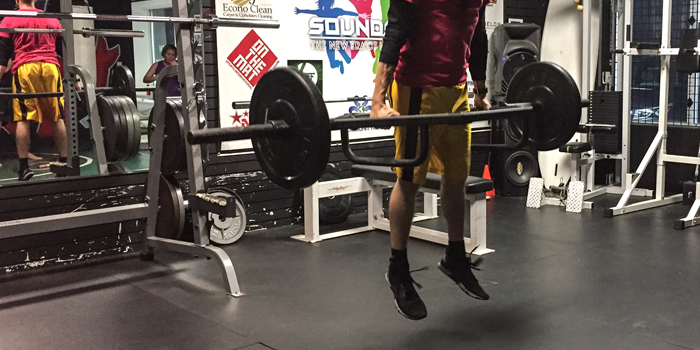
Jumps are probably the most abused tool in the health and fitness industry. Fortunately, on one side of the spectrum, we do have a group of well-informed coaches who prescribe jumps in their programs to increase athletic performance. On the other side of the spectrum, however, we still have a bunch of gurus who bastardize jumps by sacrificing the quality and power of the jump for elevating the heart rate and fatiguing the muscles and joints. While there is a naturally-occurring conditioning component to jumping—along with an abbreviated burn in the lower extremities—the objectives are to improve total body athleticism by learning to contract and relax the muscles very rapidly (primary) and to activate fast-twitch muscle fibers (secondary).
RELATED: Should I Lift or Should I Sprint — The Case for Power
The first objective is helpful when considering the positions and transitions that various athletes have a responsibility of owning if they wish to meet and exceed the level of their competition come game-time (internal motivation), as well as make the rest of their team and coaches look and feel good (external motivation). The second objective is helpful for promoting a stronger pump throughout the rest of the workout that many bodybuilders and figure competitors have come to love — and for good reason, as this plays a key role in achieving body composition goals (internal motivation), earns greater respect from peers, and enhances the first impression made on others when establishing new relationships (external motivation).
Whatever your initial objective is, just keep in mind that your training programs ultimately need to respect your safety and longevity. In other words, if you wish to keep making progress—or at least maintain what you’ve built over the years—your individual health and physiology cannot be forgotten. And this is why I’ve decided to include just the three following jump variations, which are safe when performed with moderate loads by both high-level athletes and the average person seeking better fitness. Let’s take a closer look at how to have fun with these jumps during your next workout.
1. Kettlebell Deadlift Jump
2. Trap Bar Deadlift Jump
3. Low-Angle Cable Row Jump
Execution
- Set up in the same shoulder-width foot stance for all three jumps, and bend forward as if you were dipping right over a balcony railing that’s level with your waistline. Your ass should be pushed out as if you were about to twerk it.
- Reach for the weight, and grab it with a relaxed-alertness posture.
- While camping out in this hinge position (i.e. maximal hip bend and minimal knee bend), go ahead and brace your abs as you tighten your grip on the handle/bar, followed by strengthening the rest of your body’s posture.
- Jump with as much power and aggression as you can. This will put your hips into a maximal extension for peak hang time and will prevent you from falling over that “balcony railing.” Your arms should remain straight for the deadlift jumps, and they should bend to pull the weight during the low-angle row jump (hence the name).
- Return to the ground like a ninja, landing softly on the balls of your feet first, followed by your heels. Do not mistake the “soft” part for losing solidity in your body.
- That’s one rep/jump sequence. Perform up to five total per time, focusing on quality over quantity.
Recommended Tempos
- For strength/power/skill development, reset between every jump.
- For speed/conditioning, perform all jumps in a consecutive fashion.
- For performance, switch up your jump style each rep/jump—performing both reset and consecutive styles—focusing on developing a smooth rhythm between each jump transition. The best way to describe this is to go for an informed freestyle or flow of what feels best during that particular moment.
- If you want to take these jumps to the next level, avoid landing forward from your starting position. Shoot for the same place or slightly behind where your feet are placed during your initial jumping position.
The Outstanding Theme: Make The Weight Your Bitch
Hopefully, after reviewing each loaded jump, you noticed a common theme in their execution. And that is, they all reflect a hinge movement pattern, performed explosively, more than a full range-of-motion squat. This means that there is an abundance of posterior chain activation, which further justifies the safety of the moderate loading protocol. Another thing to consider is the accelerated learning curve for teaching the practitioner (of any fitness level) how to keep their center of mass right over top of the load — which can be achieved under minimal supervision. Of course, this can still be accomplished by removing the jump from these same grounded moves. But then the athlete or individual will need to compensate for the lower intensity by increasing the load to match the force and power output of the jumping version (i.e. preserve similar low-risk, high-reward characteristics). And this is where it’s essential to sum up all this fancy lingo in the following manner: make the weight your bitch. If you’re not making the weight your bitch, chances are you’re also not making it look easy — which means it probably isn’t easy, and the load you’ve selected is too heavy. And that totally defeats the purpose. You want a challenge, but you also don’t want the acceleration from the jump to feel or look too slow.
When?
Now that you have a better understanding of how to execute these jumps, you’ll also want to consider when to include them during your workouts to remain most compatible with your goals.
- Fire up the glutes as part of a low-load warm-up combined with hip mobility work in an effort to potentiate the nervous system for deadlifts and squats.
- Include during the main workout for individuals training for higher vertical jump performance.
- Keep the nervous system activated after lower body strength work.
- Compliment speed/agility/quickness training for middle and long-distance runners, as well improve explosiveness in other recreational and elite-level athletes.
- Remind the upper body of the lower extremities by pairing jumps with some pre-exhaust/bodybuilder-pump methods, which is instantly experienced with the low-angle cable rowing/jumping hybrid move.
Not So Fast – A Final Warning!
Before getting too carried away with performing these loaded jumps (and even the common unloaded jumps), be very meticulous about mastering each position. For example, if you are executing the jumps properly, your landing position should imitate your initial jumping position. Here are some red flags to be mindful of during each phase of every jump.
- Excessive Valgus Collapse of the Knees – When the knees travel inward too much, the hips will drift to the left or right very subtly (depending on which side of your body is weaker), which will feed into more compensations/imbalances/dysfunctions over time.
- Excessive Knee Bend – When the jump resembles more of a full range-of-motion squat, be prepared to lose some power output, and thus hang time.
- Excessive Force Absorption from the Ground – A hard landing will not only decrease performance but also lead to some potential injuries that travel up the kinetic chain (i.e. ankles, knees, hip issues).
Obviously, the key word here is “excessive.” As long as you do your best to preserve a neutral hinge posture during the setup and landing phases, you should be in good shape. In this capacity, it should come to no surprise that as few as five quality jumps will be superior to hundreds of shitty jumps any day.
References
- Andrade, DC et al. Effects of General, Specific and Combined Warm-Up on Explosive Muscular Performance. Biology of Sport. 2015. Jun; 32(2): 123-128.
- Comyns, T., Kenny I. and G. Scales. Effects of a Low-Load Gluteal Warm-Up on Explosive Jump Performance. Journal of Human Kinetics. 2015. Jul; 10(46): 177-87.
- Perez-Gomez, J. and JA Calbet. Training Methods to Improve Vertical Jump Performance. The Journal of Sports Medicine and Physical Fitness. 2013. Aug; 53(4): 339-57.
- Ramirez-Campillo, R. et al. Effects of Plyometric Training on Endurance and Explosive Strength Performance in Competitive Middle- and Long-Distance Runners. Journal of Strength and Conditioning Research. 2014. Jan; 28(1): 97-104.
- Turner, TS., Tobin, DP. and E. Delahunt. Peak Power in the Hexagonal Barbell Jump Squat and its Relationship to Jump Performance and Acceleration in Elite Rugby Union Players. Journal of Strength and Conditioning Research. 2015. May; 29(5): 1234-9.
- Turner, TS., Tobin, DP. and E. Delahunt. Optimal Loading Range for the Development of Peak Power Output in the Hexagonal Barbell Jump Squat. Journal of Strength and Conditioning Research. 2015. Jun; 29(6): 1627-32.
Eric “E-Rock” Buratty is the health & fitness coordinator at MMA & Sport, located in Damascus, MD. When he’s not fine-tuning his own awesome core strength, he teaches fitness enthusiasts at all levels how to achieve their goals. Eric offers both individualized sessions and group classes, creates evidence-based health content for websites and blogs and offers expert tips on how to prevent and manage diet—for lifestyle-related health issues. To learn more about Eric and his cutting-edge advice, feel free to connect with him on Facebook.









